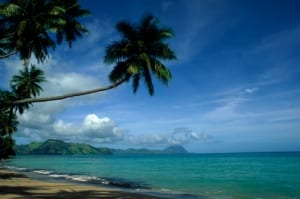
Not all bacteria are bad. Sure, there are plenty of nasty bugs that can make life pretty unpleasant; the ones that cause leprosy, anthrax, and cholera immediately come to mind.
But there are also plenty of beneficial bacteria living inside of us that we may not even know about. Some of them help us synthesize vitamins, digest milk protein, and even stop other, more harmful microbes from infiltrating our immune system.
Many of those bacteria are so tightly connected to their human hosts that they can even be used to answer questions about our ancient ancestors. It might sound far fetched, but in a new study published in this week’s Science, an international team of scientists has managed to do this by analyzing a specific kind of bacteria hidden in the digestive system of nearly half the world’s population. It is their hope that, by doing so, they can finally shed new light on how and when the first humans set foot on the Pacific islands.
Unearthing the origins and prehistory of the inhabitants of such islands as New Guinea, Samoa, and Polynesia has been no easy task. Archaeological evidence has been spotty, due to the poor preservation in the tropical climate, while genetics has often been unable to distinguish between ancient migrations and more recent, historical movements. As a result, researchers have begun turning to other disciplines to help fill in the gaps left by the more traditional fields. In this most recent case, scientists thought outside the box, using the bacteria Helicobacter pylori — or, more accurately, differences in the genetic code of Helicobacter pylori strains — to discover when various parts of the Pacific were colonized.
Helicobacter pylori (H. pylori) is a kind of bacteria in that it is present in about 50% of the world’s population. This makes it the most widespread bacterial infection on Earth. It lives in our stomachs, and is sometimes associated with ulcers or an increased risk for stomach cancer. However, more than 80% of those infected with it never know it, which may be why it is so widespread. In fact, scientists believe that an ancient strain of H. pylori was present in the stomachs of the first humans to leave Africa more than 50,000 years ago. Over the many thousands of years, H. pylori evolved into distinct strains found in distinct geographic regions. For example, one strain is only found in Europe, another only in Africa, and a third only in East Asia. So, just as genetic anthropologists use differences in our DNA to trace ancient human migrations, so too have scientists used H. pylori to reveal how humans first colonized some of the most remote parts of the world.
The current thinking about how and when the Austronesian peoples – that is, people who speak one of the many languages of island Southeast Asia and Oceania – came to colonize the Pacific Islands is, to put it mildly, unclear. While the majority of archaeologists, geneticists, and linguists all agree that the Austronesian peoples probably began their journey in present-day Taiwan, the timing and speed of their movements towards the outer rim of the Pacific Islands is a topic of great contention. So, the authors of this most recent study hoped that an analysis of H. pylori among modern-day Austronesians might give researchers new information to go on.
The authors collected samples of the bacteria from the stomachs of more than 200 individuals living in Taiwan, New Guinea, Polynesia, and dozens of other Pacific islands. Using techniques similar to those used in human DNA studies, the authors were able to track the different strains of H. pylori back to their common origin: Taiwan, about 5,000 years ago.
But how do these results stack up to findings by other researchers? Interestingly, a companion piece in the same issue of Science also examined the peopling of the Pacific, this time focusing on the linguistic history of the Austronesian peoples. That study analyzed more than 400 languages in the Austronesian linguistic family, using the similarities and differences to figure out when and where the group originated. The results of this study also support an origin of Austronesian peoples in Taiwan about 5,000 years ago. In addition, both studies argue that people expanded in a similar direction: from Taiwan eastward towards Melanesia, Oceania, and finally Polynesia and the Hawaiian Islands.
It is not hard to believe that both the study of H. pylori and of the Austronesian languages would have yielded a similar date of origin of the Austronesian peoples, especially as both studies used the same archaeological record as a point of reference. What is intriguing, however is that both studies – independent of each other – also point to similar paths of expansion of the Austronesian people once they left Taiwan.
The conclusions of these studies are far reaching, most especially because they illustrate how seemingly unrelated disciplines can be used to tackle a single question about the past. Noted Cambridge archaeologist, Professor Colin Renfrew, believes these methods – combined with the more traditional archaeological or genetic methods – allow us to see how our past is still ‘within us’ today, whether it be in our genes, in our languages, or “the bacterial flora in our guts.”



